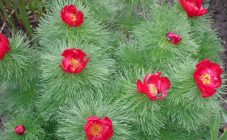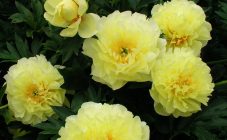Content:
September is the best time to think about creating a flower bed with peonies for the next season. It is in September that professionals advise to plant these flowers in open ground. In order for the flower garden to be decorative all season, you need to think about what to plant next to the peonies, what planting scheme to choose, how the peonies will look in the landscape design of the entire garden.
Flower garden with peonies
Before you start drawing up a flower garden plan, you need to know that:
- Peonies have been growing in one place for many years and often cannot be transplanted, so the place must be selected very carefully.
- A young plant will gain strength for several years and only then will it take its rightful place among flowers.
- Peonies are always the dominant flowers, so it is better to choose one variety and select companions for it.
- The flowering period for peonies begins in mid-May. Herbaceous species bloom for about two weeks, and tree varieties, with good care, can bloom for 3-4 weeks.
- When planting, it must be borne in mind that adult bushes need a support during the flowering period. Huge inflorescences with their weight incline the stems to the ground. The bush takes up a lot of space.
- Once the peonies have bloomed, their dark green, narrow and long leaves will serve as a great backdrop for other plant flowers.
- Peonies look great when grown in groups or single bushes in a green lawn. In this case, you can choose several varieties of different flowering periods and colors, harmoniously complementing each other.
Given all these features of creating a flower garden with peonies, you can easily determine the place and shape of the flower garden.
Flowerbed with peonies scheme
It is worth deciding what peonies are combined with. It is important to determine the compatibility of various flowers, because a flower bed with peonies should be decorative all season.
Planning any flower garden requires you to follow several important rules:
- Combination with the general landscape design of the site;
- Use of terrain features (emphasize advantages or hide disadvantages);
- Planting density;
- Duration of flowering of each plant;
- Plant such plants together so that their flowering is continuous throughout the season.
To comply with all these tricks, you need an individual approach to each project. It is important to take into account the free space for location, illumination, soil composition, the presence of nearby buildings, trees, shrubs, as well as the terrain.
Several approximate planting schemes for peonies:
- In the center is a group of 3-5 peonies of the same variety, and around the lawn grass or any ground cover plants.
- Peonies go well with hybrid tea varieties of roses. While the roses are forming buds, the peonies are already starting to bloom. When the peonies are blooming, the roses take over, and the dark green narrow leaves of the peonies serve as a great backdrop. This is an example of a lawn with peonies and roses.
- Mixborder of dominant peonies (the number of bushes depends on the size of the flower bed) + garden geranium + cuff + decorative onion + aquilegia.
- You can grow a continuous flowering flower bed of peony (1 pc.) + Siberian iris (4 pcs.) + Large rhizome geranium (4 pcs.) + Sedum (4 pcs.) + Yarrow (1 pc.) + Rod millet (1 pc.) ) + mordovnik ordinary (1 pc.).
How beautiful to plant peonies
In order for peonies to take their rightful place in garden design, you can plant them:
- on a round or single flower bed;
- on a long border or border;
- on a tiered flower bed.
Very often, a round flower bed is designed as a front one near the main entrance to a house or near a recreation area. If it is small, then peony bushes are planted in the center, and around them flowers that are shorter than their growth, with smaller inflorescences.
On a large round flowerbed, peonies can be planted not in the center, but around the circumference in several groups of 3-5 bushes, and in the center create a vertical of perennial delphiniums, hydrangeas, foxgloves and irises. The rest of the space can be filled with spring bulbous flowers (hyacinth, tulip, crocus) and perennial low-growing plants (berry, cuff, sage, poppy, bells, daylilies).
To create a long border or peony border, designers are advised to set up flower beds along garden paths on one or two sides. On these narrow long strips of land, peonies are grown as dominant, and any perennials are placed around them. In order for the flowerbed to look new every year, annual flowers (ageratum, marigolds, primroses, daisies, viola) are added to the peony. When arranging a rabat along the garden path, you can plant peonies of one variety on one side, and on the other, the other, which are combined in color or, conversely, contrasting. When arranging a curb, peony bushes are planted in the background so that during flowering they do not pile on the path and do not interfere with walking.
If your garden is large, you can use tiered planting to create great views from different points in the garden. Since plants differ in shape, size, color and growth rate, these features can be used to create a tiered flower bed with peonies.
When combining different plants to create tiers, 5 strategies can be used:
- Smooth descent involves growing tall plants in the center and a gradual change in height to the edges of the flower garden.
- The dome shape suggests a selection of plants that create a dome with clear edges.
- The design of tiers with a sharp difference in height is good in a large open area, in corner compositions or on wall beds. Here, flowering shrubs (spiraea, hydrangea, budley), tall varieties of paniculata phlox, mallow, gladiolus, and tree peony can act as dominants.
- The cone-shaped flower garden combines the strategy of the first three flower bed shapes. A tall plant is planted in the center, and then the tiers are gradually lowered, supporting each other and forming a cone.
- A tiered flower garden in the form of steps is made with intentional sharp changes in height. But the plants for each tier are selected at the same height. This shape is suitable for regular flower beds with perennial plants.
What flowers do peonies combine with?
Peonies in the landscape look great in large spaces surrounded by a green lawn, but in summer cottages it is not always possible to allocate so much space for one type of flowers.
For a small summer cottage, a peony flower bed with roses would be an excellent option. So that she is not naked, in the spring you can add any spring bulbous flowers to plantings with peonies. Tulips and peonies complement each other perfectly.In the summer, after the peonies finish blooming, against the background of their leaves, panicles of astilba, lily, godetia, daylily, petunia, nasturtium, zinnia, aster, chrysanthemum, phlox will look great.
Flowers of the Buttercup family are incompatible with peony plantings. A hellebore, anemone, lumbago, adonis, etc. can quickly deplete the soil. Their roots secrete substances that can inhibit other flowers.
When creating a peony flower garden, you must remember that peonies:
- always dominated by:
- love a lot of sun;
- long-lived plants;
- love moisture and nutritious soil;
- take up a lot of space on the flower garden.
Whatever variety of peonies the gardener likes, it is necessary to take the best place in the club for it and surround it with any other companions that the owner of the garden likes. Peonies will not last long, but will abundantly delight with their flowering, and then they will create volume and complement other flowers with green mass.
















